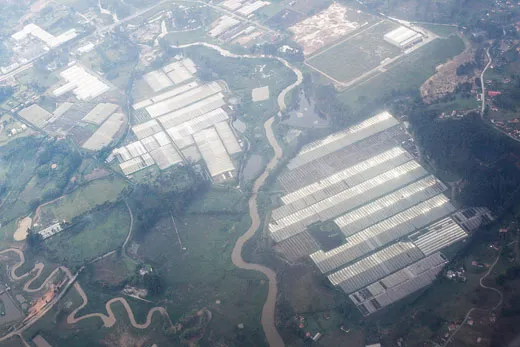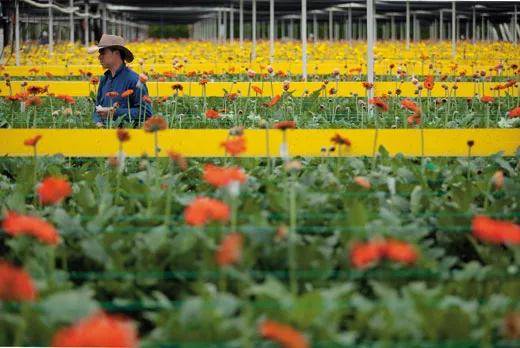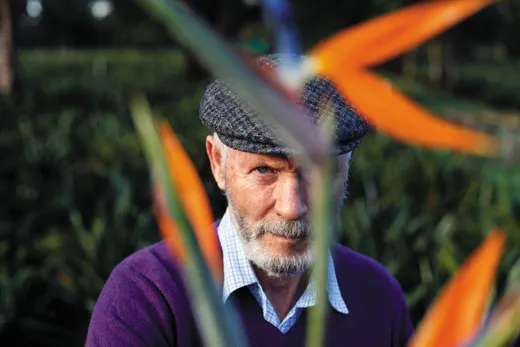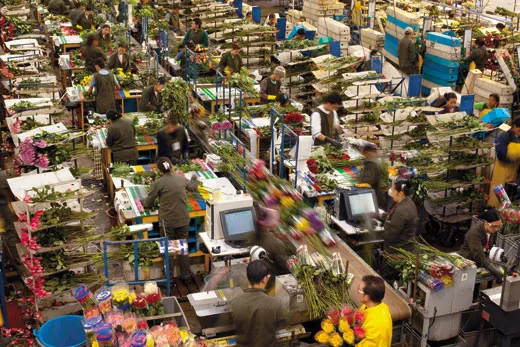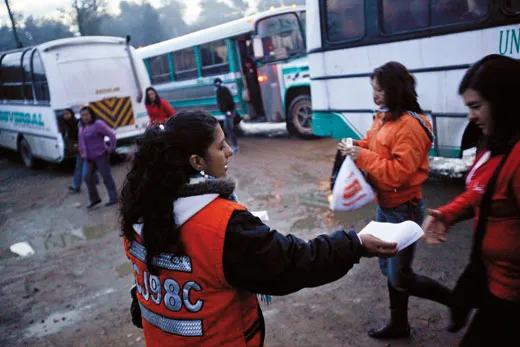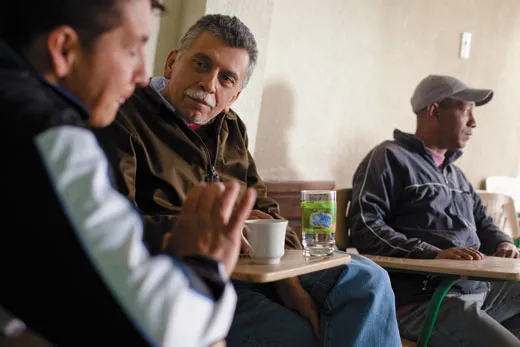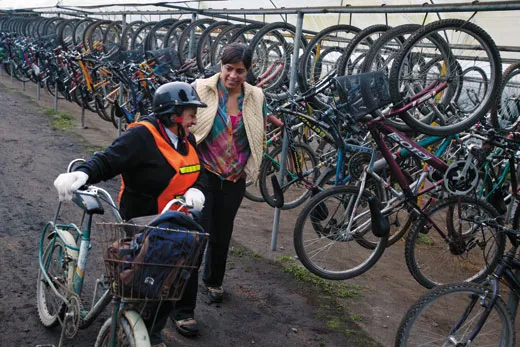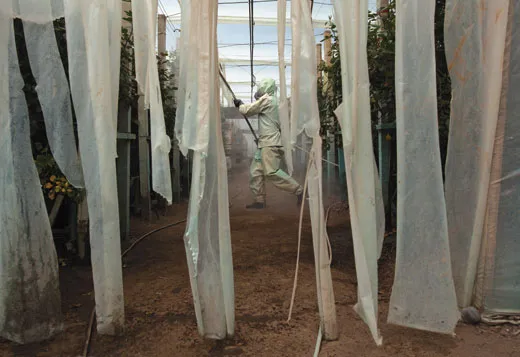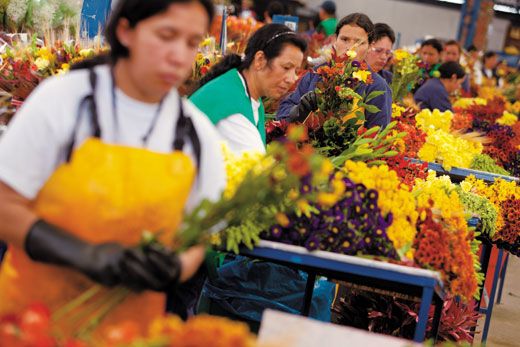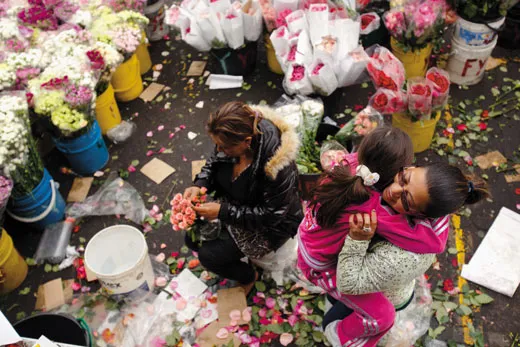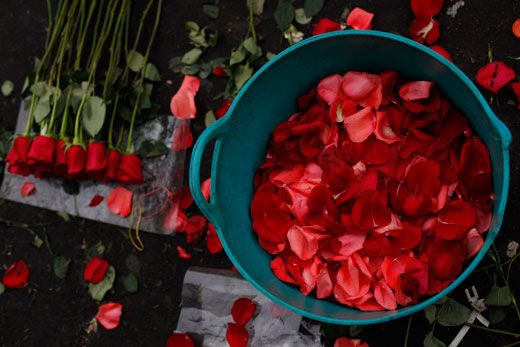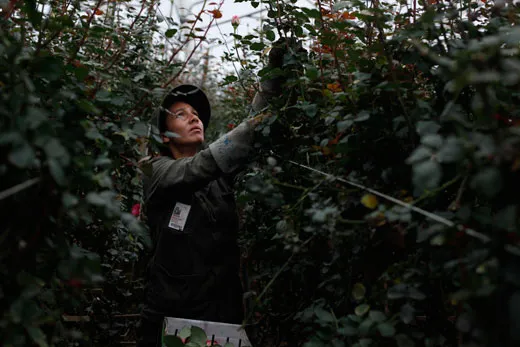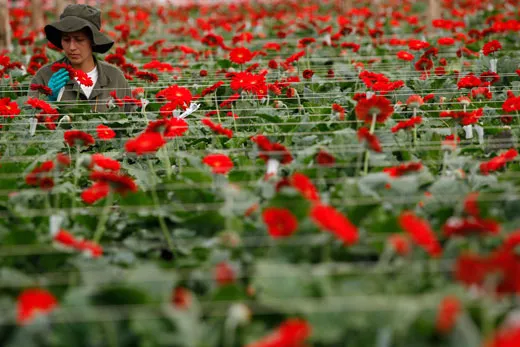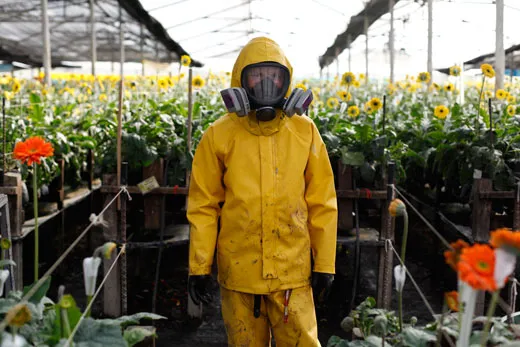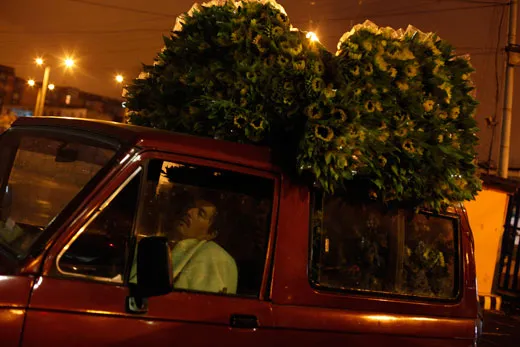The Secrets Behind Your Flowers
Chances are the bouquet you’re about to buy came from Colombia. What’s behind the blooms?
/https://tf-cmsv2-smithsonianmag-media.s3.amazonaws.com/filer/Flower-Power-gerbera-daisies-631.jpg)
In 1967 David Cheever, a graduate student in horticulture at Colorado State University, wrote a term paper titled “Bogotá, Colombia as a Cut-Flower Exporter for World Markets.” The paper suggested that the savanna near Colombia’s capital was an ideal place to grow flowers to sell in the United States. The savanna is a high plain fanning out from the Andean foothills, about 8,700 feet above sea level and 320 miles north of the Equator, and close to both the Pacific Ocean and the Caribbean Sea. Those circumstances, Cheever wrote, create a pleasant climate with little temperature variation and consistent light, about 12 hours per day year-round—ideal for a crop that must always be available. A former lakebed, the savanna also has dense, clay-rich soil and networks of wetlands, tributaries and waterfalls left after the lake receded 100,000 years ago. And, Cheever noted, Bogotá was just a three-hour flight from Miami—closer to East Coast customers than California, the center of the U.S. flower industry.
After graduating, Cheever put his theories into practice. He and three partners invested $25,000 apiece to start a business in Colombia called Floramérica, which applied assembly-line practices and modern shipping techniques at greenhouses close to Bogotá’s El Dorado International Airport. The company started with carnations. “We did our first planting in October of 1969, for Mother’s Day 1970, and we hit it right on the money,” says Cheever, 72, who is retired and lives in Medellín, Colombia, and New Hampshire.
It’s not often that a global industry springs from a school assignment, but Cheever’s paper and business efforts started an economic revolution in Colombia. A few other growers had exported flowers to the United States, but Floramérica turned it into a big business. Within five years of Floramérica’s debut at least ten more flower-growing companies were operating on the savanna, exporting some $16 million in cut flowers to the United States. By 1991, the World Bank reported, the industry was “a textbook story of how a market economy works.” Today, the country is the world’s second-largest exporter of cut flowers, after the Netherlands, shipping more than $1 billion in blooms. Colombia now commands about 70 percent of the U.S. market; if you buy a bouquet in a supermarket, big-box store or airport kiosk, it probably came from the Bogotá savanna.
This growth took place in a country ravaged by political violence for most of the 20th century and by the cocaine trade since the 1980s, and it came with significant help from the United States. To limit coca farming and expand job opportunities in Colombia, the U.S. government in 1991 suspended import duties on Colombian flowers. The results were dramatic, though disastrous for U.S. growers. In 1971, the United States produced 1.2 billion blooms of the major flowers (roses, carnations and chrysanthemums) and imported only 100 million. By 2003, the trade balance had reversed; the United States imported two billion major blooms and grew only 200 million.
In the 40 years since Cheever had his brainstorm, Colombian flowers have become another global industrial product, like food or electronics. That became apparent to me a few years ago as I stood in front of the flower display at my local supermarket before Mother’s Day (the second-biggest fresh flower-buying occasion in the United States, after Valentine’s Day). My market, in suburban Maryland, had an impressive display of hundreds of preassembled bouquets, as well as fresh, unbunched roses, gerbera daisies and alstroemeria lilies in five-gallon buckets. One $14.99 bouquet caught my eye: about 25 yellow and white gerbera daisies and a sprig of baby’s breath arranged around a single purplish rose. A sticker on the wrapping indicated it had come from Colombia, some 2,400 miles away.
How could something so delicate and perishable (and once so exotic) have come so far and still be such a bargain? It’s no secret that the inexpensive imported products Americans buy often exact a toll on the people who make them and on the environments where they are made. What was I buying into with my Mother’s Day bouquet? My search for answers took me to a barrio about 25 miles northwest of Bogotá.
In cartagenita, the buses rumble over ruts and potholes, moving slowly up and down steep hillsides lined with cinder block houses. “Turismo” is painted in flowing aquamarine script on the buses, but they are no longer used for tours. They carry workers to the flower farms.
Cartagenita is a neighborhood in Facatativá, a city of about 120,000 people and one of Colombia’s largest flower hubs. Only a few of Cartagenita’s streets are paved, and the homes are connected like town houses but without any plan, so one sometimes stands taller or shorter than the next. The barrio ends abruptly after a few blocks at open pasture. Aidé Silva, a flower worker and union leader, moved there 20 years ago. “I’ve got a house here. My husband built it,” she told me. “He worked at Floramérica, and in the afternoons and when Sunday came everybody worked building that little house.” In the years since, she said, thousands more flower workers have bought cheap land and done the same. Cartagenita has the vitality of a working-class neighborhood. There’s a buzz in the evenings as workers come home, some heading for their houses and apartments, some to hang out in the bars and open-air convenience stores.
More than 100,000 people—many displaced by Colombia’s guerrilla wars and rural poverty—labor in greenhouses spread across the savanna. Seen from an airplane, the greenhouses form geometric gray-and-white patterns reminiscent of an Escher drawing. Up close, they turn out to be bare-bones structures of plastic sheeting stapled to wooden frames. But the low-rent look is deceptive; the operations are highly sophisticated.
At a farm called M.G. Consultores, I stood on a platform above a sprawling assembly line where about 320 workers (triple the usual number—this was the run-up to Mother’s Day), most of them women, were arrayed along two long conveyor belts with 14 parallel rows of workstations on either side. The work was divided into many small, discrete tasks—measuring, cutting, bunching—before neat bundles appeared on the belt, which were then dunked in a foamy antifungal solution and boxed. Latin pop music reverberated off the corrugated metal walls. The workers were handling 300,000 rose blooms a day.
Most flowers grown in Colombia are bred in European labs, especially Dutch labs, which ship seedlings and cuttings to growers. A single gerbera plant, for instance, can last several years and produce hundreds of blooms, each one taking 8 to 12 weeks to mature. Growers change colors constantly, rotating new plants in depending on the season or consumer mood. “The tendency now is monochromatic, purple on purple,” said Catalina Mojica, who works for M.G. Consultores on labor and environmental sustainability issues. “We are two years behind fashion—usually European fashion.” Indeed, two years earlier, several top European clothing designers had featured purple in their lines.
Not so long ago, Americans got their flowers from neighborhood florists, who bought blooms grown on U.S. farms. Florists crafted bouquets and arrangements to order. They still do, of course, but this approach seems increasingly quaint. These days, the bouquets that many Americans buy, typically at supermarkets, are grown, assembled and packaged overseas. At the C.I. Agroindustria del Riofrío farm, adjacent to M.G. Consultores, dozens of bouquet assemblers were nearly swallowed up by bulging piles of gerberas, alstroemeria and sprigs of baby’s breath, all to be precisely arranged and bundled in zebra-striped plastic wrap.
Adjacent to the assembly line were spacious storerooms kept at about 34 degrees Fahrenheit. It’s no understatement to say the entire flower industry depends on that number. Selling flowers is, at bottom, an attempt to outwit death, and near-freezing temperatures can delay the inevitable. Cut a flower, and its ability to photosynthesize food from light, carbon dioxide and water soon ceases. Stored food is depleted and the flower wilts. Putting flowers in water slows that process, but only cold temperatures can arrest it for weeks at a time. It took the development of “cold chains”—refrigerated warehouses and trucks every point along the way—to ensure that flowers remain in suspended animation from farm to store.
In the cold rooms, boxes containing flowers are attached to refrigeration units that infuse them with chilled air. Then they’re stacked on pallets, which are wrapped in plastic and loaded onto trucks and driven to Miami-bound planes. (The Queen’s Flowers Corporation, one of the top importers in Miami, receives 3,000 boxes of Colombian blooms, or five tractor-trailers’ worth, on a typical day. And its shipments multiply three times during busy seasons.) It takes about 48 hours for flowers to get from a field in Colombia to a warehouse in the United States, and one or two more days to reach a retailer.
This industrial machine has been assembled at some cost. As the flower business grew, researchers for labor and environmental organizations documented the sorts of problems that typify developing economies. From the beginning, the majority of the tens of thousands of job-seekers who migrated to the savanna were women, and many of them were single mothers. Most workers made the minimum wage, which is now about $250 per month. Many of them reported sexual harassment by male bosses; working long hours without breaks; and repetitive stress injuries with no employer-provided treatment or time off. As recently as 1994, a Colombian sociologist found children as young as 9 working in greenhouses on Saturdays, and children 11 and up working 46-hour weeks in almost all areas of the farms.
A 1981 survey of almost 9,000 flower workers by scientists from Colombia, France and Britain found that the work had exposed people to as many as 127 different chemicals, mostly fungicides and pesticides. (One incentive to use pesticides: the U.S. Department of Agriculture checks imported flowers for insects, but not for chemical residues.) A 1990 study by Colombia’s National Institute of Health (NIH) suggested that pregnant Colombian flower workers exposed to pesticides might have higher rates of miscarriages, premature births and babies with congenital defects.
Colombia’s flower industry has also been profligate in its use of a vital natural resource: fresh water. Producing a single rose bloom requires as much as three gallons of water, according to a study of the Kenyan flower industry by scientists at the University of Twente in the Netherlands. The Bogotá area receives 33 inches of rainfall annually, but after flower farms and other users drilled more than 5,000 wells on the savanna, groundwater levels plunged. One engineering study reported that springs, streams and wetlands were disappearing. As Bogotá continues to expand, the city and the flower industry will be competing for the same dwindling supply.
In the 1990s, the Colombia flower industry’s success in American and European markets drew attention to its practices; a stream of reports about harsh treatment of workers and depletion of natural resources followed. At the same time, consumers began to care more about how their goods were being produced, so Colombia’s flower farms began to respond. “It’s definitely improved over time, particularly as a result of the different organizations giving everybody adverse publicity,” says Catherine Ziegler, author of the book Favored Flowers, about the global industry.
In 1996, Colombia began a series of initiatives, still underway, to eliminate child labor, and international labor groups report that it has been greatly reduced in the cut-flower business. Farms belonging to the flower exporters association, Asocolflores (about 75 percent of the total), have moved to replace the more hazardous classes of agricultural chemicals, says Marcela Varona, a scientist at the environmental health laboratory at Colombia’s NIH. (But researchers note that flower workers who have used hazardous chemicals in the past may continue to be affected for years.)
In addition, the flower industry created Florverde, a voluntary certification program that requires participating farms to meet targets for sustainable water use and follow internationally recognized safety guidelines for chemical applications. At several farms I visited, the plastic sheeting on greenhouse roofs had been extended and reshaped to collect rainwater. Farms participating in Florverde have reduced their groundwater use by more than half by collecting and using rainwater, says Ximena Franco Villegas, the program’s director.
At the same time, slightly fewer than half of Asocolflores farms participate in Florverde, and government oversight remains weak. “The industry is self-regulated, so it’s up to the owner and up to his ethics what he does,” says Greta Friedemann-Sanchez, a University of Minnesota anthropologist and author of the book Assembling Flowers and Cultivating Homes: Labor and Gender in Colombia. “There are facilities that have enough washrooms, bathrooms, lockers, cafeterias, a subsidized lunch workers can purchase, recycle all organic material, trying to do biological control of pests and fungus, and follow labor laws. And then there are firms that don’t do any of those things.”
Similarly, labor disagreements continue. At the Facatativá headquarters of Untraflores, the flower workers union Aidé Silva helped organize in the early 2000s, she told me that after 19 years in the industry, she lost her job in late 2009 in a corporate reorganization—an action she says her employer, Flores Benilda, took to break the union after workers shut down a farm to protest pay and benefit cuts. Moreover, Silva says Benilda drained an $840,000 employee support fund that workers had been contributing to for 20 years, leaving only about $8,000. Benilda did not respond to requests for comment.
The global economic crisis has had an impact, too. “The dollar has fallen, the peso has been revalued, the competition from other countries has grown, as has the focus on supermarkets,” said Untraflores’ political adviser, Alejandro Torres. “These changes in the global flower markets have generated costs, and those get put on the workers.” Thousands of workers have been laid off, and some flower farms have moved away from hiring employees in favor of contracting labor; Torres and Silva say the arrangement allows the farms to stop paying the employer share of government social security and medical benefits.
By contrast, Catalina Mojica says M.G. Consultores is actually working to retain employees. Mojica’s focus on collecting data about working conditions and her willingness to talk with local officials and reporters, for example, represents a change for the industry; farm owners have tended to be secretive about their business operations and rarely meet with outsiders. “They don’t get together and BS with people,” she says. “Some owners don’t know the local government officials, they don’t know the [labor and environmental groups]. We’re still very awkward. It’s not something people do.”
“What is expensive for us is people moving from the industry—so we have to keep people happy here,” says María Clara Sanín, a sustainability consultant who has worked with flower farms. At Flores de Bojacá, a farm west of Bogotá that employs about 400 people, there’s an elected employee council that can air complaints to management. The farm has a day care center, a nice cafeteria and machines that strip the thorns off roses—a task usually performed by hand, with special gloves, and a major cause of repetitive stress injuries.
Ultimately, many flower workers have improved their lot. Sanín’s firm, Enlaza, recently surveyed hundreds of women at M.G. Consultores and found that most had previously worked on subsistence farms or as maids, jobs that paid lower wages than the flower industry. Women with their own incomes have more autonomy than those dependent on husbands, says Friedemann-Sanchez, the anthropologist. She answered my original question—What was I buying into if I bought a Colombian bouquet?—with one of her own: “If you don’t buy flowers, what’s going to happen to all these women?”
As I tried to sort out these conflicting snapshots of the industry, I kept coming back to what a flower worker named Argenis Bernal had told me about her life. She began laboring on flower farms when she was 15. Because she was a good worker, she said, she was assigned to the harvest, wielding her clippers along pathways between long lines of flower beds, amassing stacks of roses, carnations, gerberas and other blooms.
“You spend all your time hunched over, from the time they sow the seedling to the time the stems are cut,” she said. “That’s the work, all day long.”
After about a decade, she said, she had to stop harvesting. Now she’s 53, and “I’ve got these problems with my spinal column and with repetitive motion.” She still spends eight hours a day at a farm outside Facatativá owned by Flores Condor, fastening new carnation buds onto the stems of mother plants.
“I’ve stuck it out there because I have only a couple of years until I qualify for a pension,” she says. She and her husband, who have four children, are putting one of their sons through a business management program at a regional community college. Their teenage daughter is hoping to study there, too.
The global marketplace will always demand cheaper flowers, and Colombian farms must compete with growers in other nations, including neighboring Ecuador and rising flower power Kenya. Increasingly, though, there’s another factor flower growers must consider: independent flower certification programs, including Fair Trade flowers, VeriFlora and the Rainforest Alliance, which are working to certify farms in Colombia.
Such programs have been key to Colombia’s business in Europe, where customers pay close attention to the source of their flowers. The U.S. trade in certified flowers is tiny by comparison—my Mother’s Day bouquet bore no certification notice—but growing. “Sustainability is an attribute that consumers are seeking,” says Linda Brown, creator of the certification standards for VeriFlora, which is based in Emeryville, California. “When you are looking 10 to 20 years out, sustainability will become the way that people do business.”
As for David Cheever, he had an eventful ride through the revolution he started with his grad school paper. He says he and his colleagues differed and he was forced out of Floramérica in July 1971, not long after it started. “I went home and cried all afternoon,” he says. But he went on to create his own success, starting carnation-propagation businesses. “I feel myself as more of a missionary than an entrepreneur,” he says.
John McQuaid has written extensively on environmental issues. Ivan Kashinsky is a contributor to the book Infinite Ecuador.
